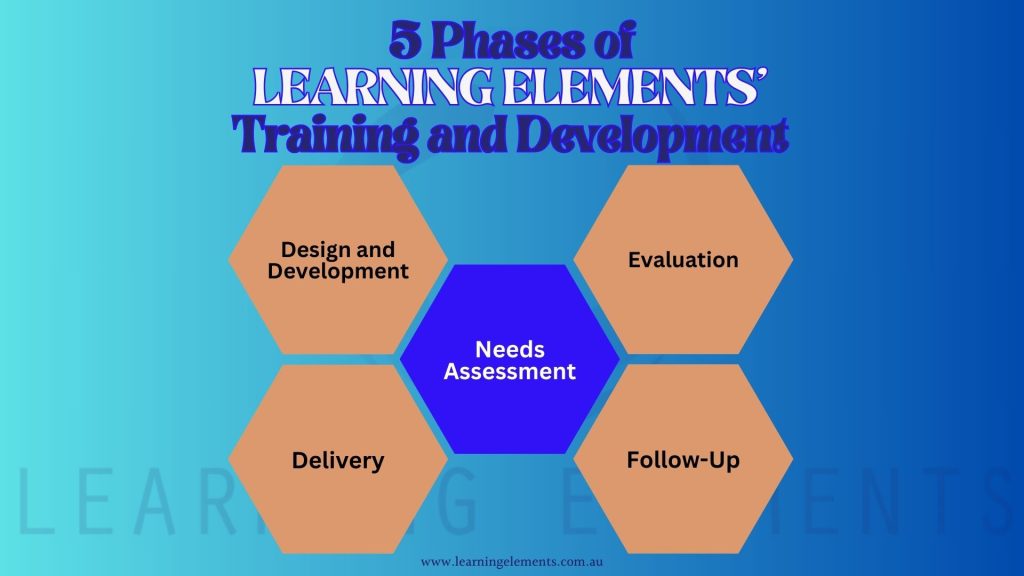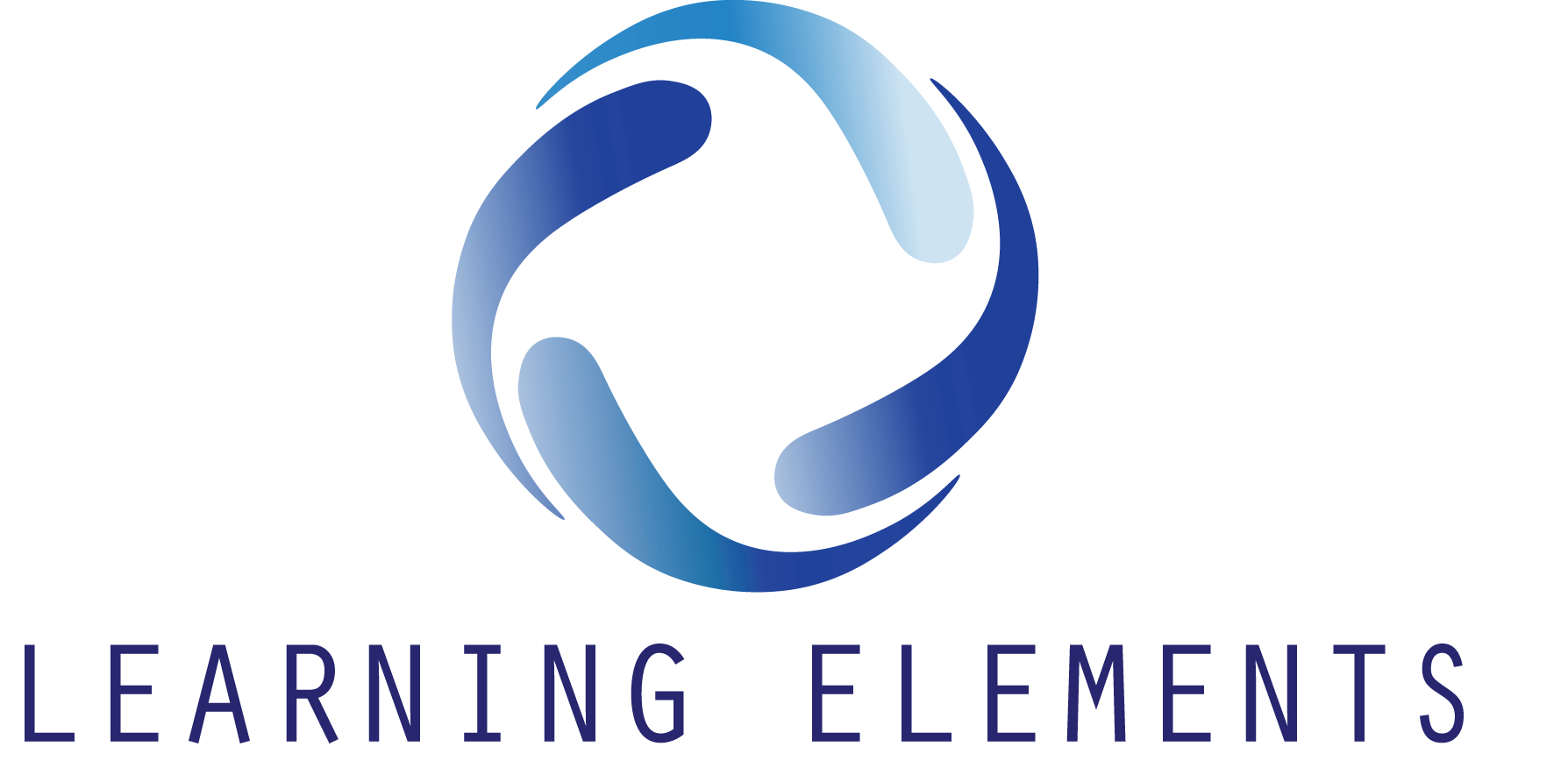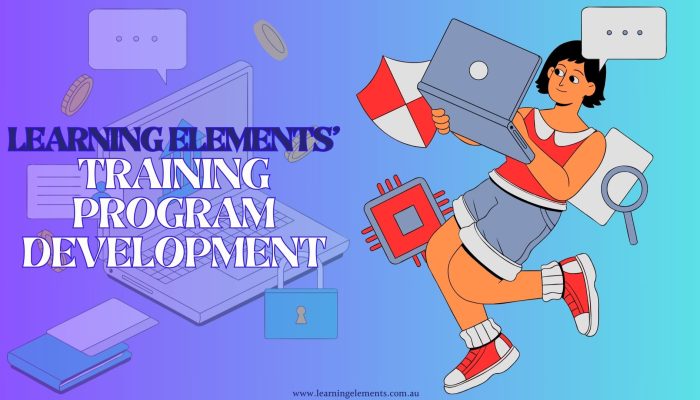Training Program Development: From Concept to Execution
Training program development is crucial to laying the groundwork for organisational advancement. The process involves a methodical blend of strategic planning, educational expertise, and organisational insight, from conceptualisation to implementation. Learning Elements’ transformative endeavour guides our training experts through learning needs assessment, curriculum design, delivery methodologies, and performance evaluation. With a steadfast commitment to excellence, we craft tailored solutions to address each department’s specific challenges and goals. Our training program development lies in enhancing skills, fostering innovation, and enabling individuals to reach their full potential. Through our approach that integrates technology, inclusivity, and continuous improvement, organisations pave the way for sustainable growth and competitive advantage.
How Does the Learning Elements Team Develop a Training and Development Process?
Identify the need for training and development:
The first step is to conduct a thorough needs assessment to identify gaps in the organisation’s knowledge, skills, and competencies. This may involve analysing performance data, conducting employee surveys or interviews, and considering organisational objectives and future challenges.
Set specific goals and objectives:
Once the training needs have been identified, it’s essential to establish clear and measurable goals and objectives for the training program. These goals should align with the organisation’s overall strategic objectives and address the skills or competencies that must be developed.
Decide on training methods and develop a detailed plan:
Based on the identified needs and objectives, we determine the most effective training methods and develop a detailed plan for delivering the training. This may include a combination of methods such as classroom training, e-learning, on-the-job training, workshops, mentoring, and coaching. The plan should outline the content, delivery schedule, resources required, and evaluation criteria.
Implement the training program:
With the plan in place, it’s time to implement it. This involves scheduling training sessions, preparing training materials, and communicating the objectives and expectations with participants. We ensure that the Learning Elements team of trainers prepares adequately and provides participants with the necessary resources and support to fully engage in the training activities.
Evaluate the output:
Evaluation is a critical step in the training process to assess the program’s effectiveness and measure the impact on employee performance and organisational outcomes. This may involve collecting participant feedback, assessing learning outcomes through tests or assessments, and evaluating changes in behaviour or performance metrics.
Monitor performances:
Beyond the immediate evaluation of the training program, ongoing monitoring of employee performance is essential to gauge the long-term impact of the training. This may involve tracking key performance indicators, conducting follow-up assessments, and providing additional support or reinforcement.
Continuous improvement:
Finally, the training and development process should be viewed as iterative, with opportunities for continuous improvement based on feedback, evaluation results, and changes in organisational needs. By regularly reviewing and updating training programs, organisations can ensure they remain relevant and effective in helping employees develop the skills and competencies needed to succeed.
With these steps, organisations can develop and implement effective training and development processes that support their strategic objectives and contribute to the growth and success of their employees and the organisation as a whole.
Keen to gain deeper insights? Schedule a 30-minute call with us or enrol in our comprehensive training course.

Why Choose Learning Elements for Your Training Program Development?
Tailored Solutions
At Learning Elements, we understand that one size does not fit all, so we tailor our training programs to meet each department or team’s specific needs and objectives within your organisation. We ensure that our customised approach aligns training initiatives with different business units’ unique challenges and goals, maximising relevance and impact.
Technology Integration
From utilising cutting-edge learning management systems (LMS) to interactive online platforms and virtual reality (VR) simulations, we leverage technology to deliver engaging and immersive learning experiences and meet the evolving needs of modern learners. Our training initiatives remain dynamic, effective, and future-ready by consistently embracing technological advancements. The Learning Elements integrate storyboards into our approach alongside LMS and VR simulations to create dynamic learning environments. Storyboarding allows us to visually plan and sequence our training content, ensuring it is engaging and effectively communicates key concepts. Interactive e-learning modules, gamified exercises, and mobile learning apps further enhance accessibility and engagement, catering to diverse learning preferences and styles. Our trainers are proficient in utilising these tools to deliver interactive sessions, facilitate discussions, and provide real-time feedback, fostering active participation and knowledge retention.
Employee Engagement Strategies
Engaging participants is vital for the success of any training program, and at Learning Elements, we employ a range of innovative strategies to foster active participation and enthusiasm among learners. We design interactive exercises, gamification elements, and peer collaboration activities to engage and motivate employees, enhancing knowledge retention.
Inclusivity and Accessibility
We commit to providing inclusive and accessible training experiences for all employees, regardless of their background or abilities. We go the extra mile to accommodate diverse learning styles, preferences, and needs, ensuring everyone can access valuable learning opportunities equally. Promoting diversity and inclusion principles in our training initiatives creates an environment where every employee can thrive and succeed.
Long-Term Support
Learning Elements commitment to your organisation doesn’t end with completing a training program. We offer ongoing support and resources to ensure the learning journey continues long after the initial training sessions. Whether it’s access to additional learning materials, ongoing mentorship opportunities, or avenues for continued professional development, we’re here to support your employees every step of the way.

What are the 5 phases of our training and development?
Needs Assessment:
This initial process sets the foundation for the entire training and development program. It involves thoroughly examining the organisation’s objectives and the skills required. By identifying the gaps between current and desired performance, organisations can pinpoint the specific training needs of their employees. This may involve surveys, interviews, performance reviews, and analysis of business metrics to understand where improvements are necessary.
Design and Development:
Once the training needs have been identified, the next step is to design and develop the program. This involves creating the curriculum, selecting appropriate training methods and materials, and outlining the learning objectives. Design and development also consider the target audience, learning styles, and available resources. The aim is to ensure the training content is relevant, engaging, and aligned with the organisation’s goals.
Delivery:
Delivery is the phase where the actual training takes place. This can occur through various methods, such as instructor-led sessions, e-learning modules, workshops, on-the-job training, or a combination of these approaches. The delivery phase focuses on providing the necessary information and skills to participants in an effective and engaging manner. Trainers are crucial in facilitating learning and ensuring participants understand and retain the material.
Evaluation:
Evaluation is crucial in assessing the program’s effectiveness and its impact on the organisation. It can manifest in various ways, including participant reactions, learning outcomes, behavioural changes, and overall business impact. Various methods, such as surveys, assessments, observations, and performance metrics, measure the training program’s success. The findings from the evaluation phase provide valuable insights for improving future training initiatives.
Follow-Up:
The follow-up process ensures that learning is reinforced and applied in the workplace. This may involve providing additional support and resources to participants, offering practice and skill development opportunities, and encouraging feedback and ongoing communication. Follow-up activities maintain momentum from training and guarantee the integration of new knowledge and skills into everyday work practices.
Conclusion
At Learning Elements, we are dedicated to revolutionising the training sphere through our comprehensive and innovative approach to training program development. By blending strategic planning, educational expertise, and cutting-edge technology, we empower organisations to unlock their full potential and achieve sustainable growth. Whether you’re looking to address specific skill gaps, enhance employee performance, or stay ahead of industry trends, our tailored solutions and industry-leading training courses are designed to meet your unique needs. Take the next step towards organisational excellence by partnering with Learning Elements today.
Ready to transform your training program? Enquire about our tailored solutions and enrol in our comprehensive training courses today. Schedule a consultation with us to discuss your training needs!

